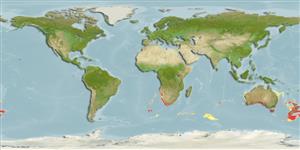Common names from other countries
>
Zeiformes (Dories) >
Cyttidae (Lookdown dories)
Etymology: Cyttus: Greek, kyttaros, kytos = a convex cavity.
Environment: milieu / climate zone / depth range / distribution range
Ecologia
marinhas batidemersal; intervalo de profundidade 200 - 978 m (Ref. 50308). Deep-water; 18°S - 55°S, 5°W - 173°W
Southeast Atlantic: Walvis Ridge and from off Cape Town to Algoa Bay in South Africa. Indo-West Pacific: south coast of Australia and New Zealand.
Length at first maturity / Tamanho / Peso / Idade
Maturity: Lm 21.6 range ? - ? cm
Max length : 63.0 cm TL macho/indeterminado; (Ref. 123586); common length : 33.0 cm TL macho/indeterminado; (Ref. 9258)
Espinhos dorsais (total) : 9 - 10; Raios dorsais moles (total) : 35 - 37; Espinhos anais: 2; Raios anais moles: 36 - 38. Adults silvery grey in color; juveniles (to 10 cm) silvery with brown blotches (Ref. 4253).
Occurs in offshore waters (Ref. 9258). Juveniles pelagic in surface waters (Ref. 9563).
Life cycle and mating behavior
Maturities | Reprodução | Spawnings | Egg(s) | Fecundities | Larvas
Heemstra, P.C., 1986. Zeidae. p. 435-438. In M.M. Smith and P.C. Heemstra (eds.) Smiths' sea fishes. Springer-Verlag, Berlin. (Ref. 4253)
Categoria na Lista Vermelha da IUCN (Ref. 130435)
CITES (Ref. 128078)
Not Evaluated
Ameaça para o homem
Harmless
Utilização humana
Pescarias: espécies comerciais
Ferramentas
Relatórios especiais
Descarregue XML
Fontes da internet
Estimates based on models
Preferred temperature (Ref.
115969): 5.9 - 12.8, mean 8.3 (based on 194 cells).
Phylogenetic diversity index (Ref.
82804): PD
50 = 0.7500 [Uniqueness, from 0.5 = low to 2.0 = high].
Bayesian length-weight: a=0.01950 (0.00831 - 0.04576), b=3.00 (2.79 - 3.21), in cm Total Length, based on LWR estimates for this (Sub)family-body shape (Ref.
93245).
Nível Trófico (Ref.
69278): 3.9 ±0.87 se; based on food items.
Resiliência (Ref.
120179): Muito baixo, tempo mínimo de duplicação da população maior que 14 anos (tm=5.2-6.3; Tmax=38; K=0.04-0.07).
Fishing Vulnerability (Ref.
59153): High to very high vulnerability (70 of 100).
Climate Vulnerability (Ref.
125649): High to very high vulnerability (74 of 100).
